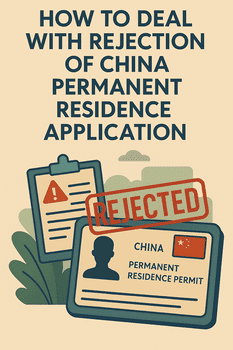
China’s permanent residence system has evolved significantly in recent years, with the introduction of the enhanced “Five-star Card” system in 2023 and a points-based evaluation framework that has transformed the application process.
Despite increasing approval rates—from 29% in 2022 to 38% in 2024 according to the National Immigration Administration Annual Report—obtaining permanent residence in China remains a selective process with rigorous requirements 1.
Common Reasons for Application Rejection
Understanding why applications are rejected is crucial for developing an effective reapplication strategy:
1. Professional Qualification Issues
- Insufficient professional achievements for “foreign expert” classification
- Educational qualifications below doctoral or specialized master’s level
- Expertise not aligned with China’s current development priorities
- Lack of prestigious professional recognition or awards 2
2. Financial and Investment Shortfalls
- Income below category-specific thresholds (e.g., ¥600,000 annually for skilled professionals)
- Inconsistent income history during the qualifying period
- Insufficient investment amounts for investor-track applicants
- Investments in non-priority sectors 3
3. Documentation Problems
- Missing or improperly authenticated documents (43% of rejections in 2024)
- Expired certificates or inconsistencies between documents
- Improper translation of foreign documents
- Insufficient evidence of previous legal residence 2
4. Residency Requirements Not Met
- Insufficient time spent in China (typically less than required consecutive years)
- Excessive time outside China during the qualifying period
- Gaps in legal residence status
- Previous residence primarily on short-term visas 2
5. Regional Variations and Quotas
- Application submitted in regions with stricter evaluation criteria
- Local quotas already filled in high-demand areas
- Different priority sectors across regions 1
The Appeal Process: Your Rights and Options
When facing rejection, you have several formal recourse options:
Administrative Reconsideration
- Must be filed within 60 days of receiving the rejection decision
- Requires written submission with new supporting evidence
- Success rate: approximately 18% (2024 statistics)
- Process handled by the Administrative Review Committee of the Ministry of Public Security 4
Administrative Litigation
- Available if administrative reconsideration is unsuccessful
- Must be filed within 15 days of the reconsideration decision
- Success rate: approximately 12% (2024 statistics)
- Requires legal representation 4
Strategies for Successful Reapplication
1. Address Specific Rejection Reasons
- Request a detailed explanation of rejection reasons from the Exit-Entry Administration Bureau
- Focus improvements specifically on cited deficiencies
- Reapplication success rate: approximately 31% when addressing previous rejection reasons 1
2. Strengthen Your Documentation
| Document Type | Authentication Required | Validity Period | Translation Requirements |
|---|---|---|---|
| Birth certificate | Yes – Apostille | No expiration | Certified Chinese translation |
| Academic credentials | Yes – Ministry of Education | 6 months | Certified Chinese translation |
| Criminal record | Yes – Home country authority | 6 months | Certified Chinese translation |
| Financial statements | Bank seal required | 3 months | Certified Chinese translation |
Source: China Immigration Service Center Documentation Guidelines 2024 1
3. Consider Regional Advantages
| Region | Annual Quota (2024) | Processing Time | Local Requirements |
|---|---|---|---|
| Shanghai | 3,500 | 6-8 months | Additional financial stability proof |
| Beijing | 3,200 | 7-9 months | Higher income thresholds |
| Guangdong | 4,100 | 5-7 months | Industry-specific preferences |
| Hainan | 1,800 | 4-6 months | Lower investment thresholds |
Source: Regional Immigration Offices Annual Quota Announcements 1
4. Seek Professional Assistance
- Applications with professional representation show a 27% higher approval rate
- Budget ¥30,000-80,000 for comprehensive professional assistance
- Consult the Official Registry of Authorized Immigration Consultants 1
5. Enhance Your Qualifications
- Improve Chinese language proficiency
- Increase community involvement and cultural integration
- Secure stronger institutional support from respected Chinese organizations
- Align your expertise with China’s current priority sectors 2
Managing Delays in the Application Process
While waiting for permanent residence approval or preparing for reapplication, consider these interim visa solutions:
| Visa Type | Duration | Renewal Options | Best For |
|---|---|---|---|
| Work Permit (Class A) | 2-5 years | Renewable | High-skilled professionals |
| Talent (R) Visa | 5-10 years | Renewable | Recognized experts |
| Personal Affairs (Q1) | 1-2 years | Renewable | Family reunion cases |
| Private Affairs (S1) | 1-2 years | Renewable | Dependent family members |
Source: National Immigration Administration Visa Guidelines 5
Monitoring Policy Changes
Stay informed about recent policy developments that may affect your application:
- The State Immigration Administration announced a new digital processing system in March 2024 aimed at reducing permanent residence processing times by 30% by the end of 2025
- Key improvements include centralized document verification, automated preliminary screening, standardized evaluation criteria, and an integrated background check system 5
Conclusion
While rejection of a permanent residence application can be disappointing, understanding the specific reasons for denial and taking strategic steps to address them can significantly improve your chances of success in subsequent applications.
The formal appeal process provides additional avenues for recourse, though success rates remain relatively modest.
By carefully analyzing your rejection, strengthening your qualifications, ensuring impeccable documentation, and potentially seeking professional assistance, you can develop an effective strategy for navigating China’s evolving permanent residence system.



